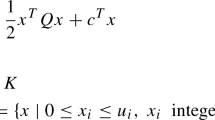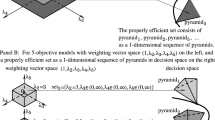Abstract
Convex quadratic programming (QP) as applied to portfolio planning is established and well understood. In this paper, presented in two parts, we highlight the importance of choosing an algorithm that processes a family of problems efficiently. In Part I in particular we describe an adaptation of the simplex method for QP. The method takes advantage of the sparse features of simplex and the use of the duality property makes it ideally suited for processing the discrete optimisation models. Part II (to be published in issue 8/4) of the paper considers a family of discrete QP formulations of the portfolio problem, which captures threshold constraints and cardinality restrictions. We describe the adaptation of a novel method ‘branch, fix and relax’ to process this class of models efficiently. Theory and computational results are presented.

Similar content being viewed by others
References
Barankin, E. W. and Dorfman, R. (1958) ‘On Quadratic Programming’, University of California Publications in Statistics, 2, 285–318.
Beale, E. M. L. (1968) Mathematical Programming in Practice, Pitman, London.
Beale, E. M. L. (1959) ‘On Quadratic Programming’, Naval Research Logistics Quarterly, 6, 227–243.
Beale, E. M. L. (1969), in J. Abadie (ed.) Advanced Algorithms Facilities for Mathematical Programming Systems, Integer and Nonlinear Programming, North Holland, Amsterdam.
Beasley, J. E. (1996) Advances in Linear and Integer Programming, Oxford University Press, Oxford.
Beasley, J. E., Chang, T. -J., Meade, N. and Sharaiha, Y. M. (2000) ‘Heuristics for Cardinality Constrained Portfolio Optimisation’, Computers and Operations Research, 27, 1271–1302.
Bienstock, D. (1996) ‘Computational Study of a Family of Mixed-integer Quadratic Programming Problems’, Mathematical Programming, 74, 121–140.
Blin, J. (1995), Private Communications, New York and London.
Cottle, R. W. and Dantzig, G. B. (1968a) ‘Complementary Pivot Theory of Mathematical Programming’, Mathematics of Decision Science, 115–136.
Cottle, R. W. and Dantzig, G. B. (1968b) ‘Complementary Pivot Theory of Mathematical Programming’, Linear Algebra and Its Applications, 1, 103–125.
Dantzig, G. B. (1963) Linear Programming and Extensions, Princeton University Press, Princeton, NJ.
Duran, M. A. and Grossmann, I. E. (1986) ‘An Outer-Approximation Algorithm for a Class of Mixed-Integer Nonlinear Programs’, Mathematical Programming, 36, 307–399.
Ellison, E. D. F., Hajian, M., Levkovitz, R., Maros, I. and Mitra, G. (1999) A Fortran Based Mathematical Programming System: FortMP, Brunel University, Uxbridge, UK and NAG Ltd, Oxford, UK.
Elton, E. J. and Gruber, M. J. (1995) Modern Portfolio Theory and Investment Analysis, 5th edn, John Wiley, New York.
Fletcher, R. and Leyffer, S. (1994) ‘Solving Mixed Integer Nonlinear Programs by Outer Approximation’, Mathematical Programming, 8(2), 327–349.
Fletcher, R. and Leyffer, S. (1995) ‘Numerical Experience with Lower Bounds for MIQP Branch-and-Bound’, Dundee Numerical Analysis Report, University of Dundee.
Grinold, R. C. and Kahn, R. N. (1995) Active Portfolio Management: Quantitative Theory and Applications, McGraw-Hill, New York.
Goldfarb, D. and Idnani, R. (1983) ‘A Numerically Stable Dual Method for Solving Strictly Convex Quadratic Programs’, Mathematical Programming, 27, 1–33.
Hadley, G. F. (1964) Nonlinear and Dynamic Programming, Addison Wesley, Reading, MA.
Hanoch, G. and Levy, H. (1969) ‘The Efficiency Analysis of Choices Involving Risk’, Review of Economic Studies, 36, 335–346.
Hohenbalken, B. V. (1975) ‘A Finite Algorithm to Maximize Certain Pseudo Concave Functions on Polytopes’, Mathematical Programming Journal, 8, 189–206.
Jobst, N. J., Horniman, M. D., Lucas, C. A. and Mitra, G. (2001) ‘Computational Aspects of Alternative Portfolio Selection Models in the Presence of Discrete Asset Choice Constraints’, Quantitative Finance, 1, 1–13.
Kallberg, J. G. and Ziemba, W. T. (1983) ‘Comparison of Alternative Utility Function in Portfolio Selection Problems’, Management Science, 29, 1257–1276.
Kuhn, H. W. and Tucker, A. W. (1951) ‘Nonlinear Programming’, Proceedings of the Second Berkeley Symposium on Mathematical Statistics and Probability, 481–492. Berkeley, California.
Kuhn, H. W. and Tucker, A. W. (1956) Linear Inequalities and Related Systems, Princeton University Press, Princeton, NJ.
Lazimy, R. and Levy, A. (1983) ‘The Effects of Variable and Fixed Transaction Costs on Optimal Investment Decisions’, Decisions Sciences, 14, 527–545.
Lazimy, R. (1985) ‘Improved Algorithm for Mixed-Integer Quadratic Programs and a Computational Study’, Mathematical Programming, 32, 100–113.
Lemke, C. E. (1968) ‘On Complementary Pivot Theory’, in G. B. Dantzig and A. F Veinott (eds.), Mathematics of the Decision Sciences Part I, Lectures in Applied Mathematics, Vol. 11, 95–114.
Lintner, J. (1965) ‘The Valuation of Risk Assets and the Selection of Risky Investments in Stock Portfolio and Capital Budgets’, Review of Economics Statistics, 16, 13–37.
Markowitz, H. M. (1952) ‘Portfolio Selection’, Journal of Finance, 7, 7–91.
Markowitz, H. M. (1959, 1970) Portfolio Selection: Efficient Diversification of Investments, John Wiley, New York, Yale University Press, New Haven, CT.
Maros, I. (2003) Computational Techniques of the Simplex Method, Kluwer Academic Publishers, Dordrecht.
Maros, I. and Mitra, G. (1996) ‘Simplex Algorithms’, in J. E. Beasley (ed.), Advances in Linear and Integer Programming, Chapter 1, Oxford University Press, Oxford.
Maros, I. and Mitra, G. (1998) ‘Strategies for Creating Advanced Bases for Large Scale Linear Programming Problems’, INFORMS Journal on Computing, USA, 10(2), 248–260.
Meszaros, Cs. (1998) ‘The BPMPD Interior Point Solver for Convex Quadratic Problems’, Working paper WP 98-8, Computer and Automation Institute, Budapest.
Mitra, G. (1966), Private Communication and Notes, submitted to E.M.L. Beale.
Mitra, G. (1973) ‘Investigation of Some Branch and Bound Strategies for the Solution of Mixed Integer Linear Program’, Mathematical Programming, 4, 155–170.
Mitra, G., Kyriakis, T. and Lucas, C. (2003) ‘A Review of Portfolio Planning: Models and Systems’, in S. E. Satchell, A. E. Scowcroft (eds.), Advances in Portfolio Construction Implementation, an invited chapter, Butterworth & Heinemann, Oxford, 1–3.
Mossin, J. (1966) ‘Equilibrium in a Capital Asset Market’, Econometrica, 34, 768–783.
Perold, A. F. (1984) ‘Large-Scale Portfolio Optimization’, Management Science, 30, 1143–1160.
Quesada, I. and Grossmann, I. E. (1992) ‘An LP/NLP Based Branch-and-Bound Algorithm for Convex MINLP Optimization Problems’, Computers and Chemical Engineering, 16, 937–947.
Rosenberg, B. (1974) ‘Extra-Market Components of Covariance in Security Returns’, Journal of Financial and Quantitative Analysis, 9, 263–273.
Ross, S. A. (1976) ‘The Arbitrage Theory of Capital Asset Pricing’, Journal of Economic Theory, 13, 341–360.
Sharpe, W. F. (1963) ‘A Simplified Model for Portfolio Analysis’, Management Science, 9, 277–293.
Sharpe, W. F. (1964) ‘Capital Asset Prices: A Theory of Market Equilibrium Under Conditions of Risk’, Journal of Finance, 19, 425–442.
Sharpe, W. F. (1971) ‘A Linear Programming Approximation for the General Portfolio Analysis Problem’, Journal of Financial and Quantitative Analysis, 6, 1263–1275.
Vanderbei, R. J. (1996) Linear Programming: Foundations and Extensions, Kluwer Academic Publishers, Dordrecht.
Vanderbei, R. J. (Nov, 1998) ‘LOQO: An Interior Point Method for Quadratic Programming’, Technical Report, Princeton University.
Van-de Panne, C. and Whinston, A. (1964) ‘The Simplex and the Dual Method for Quadratic Programming’, Operational Research Quarterly, 15, 355–388.
Van-de Panne, C. and Whinston, A. (1969) ‘The Symmetric Formulation of the Simplex Method for Quadratic Programming’, Econometrica, 37(3), 507–527.
Wolfe, P. (1959) ‘The Simplex Method for Quadratic Programming’, Econometrics, 27, 382–398.
Wright, S. J. (1996) Primal-Dual Interior-Point Methods, SIAM, Philadelphia.
Author information
Authors and Affiliations
Corresponding author
Additional information
2was educated at Clifton College Bristol and at The Queen's College Oxford, where he received a first class honours degree in mathematics. Subsequently, he worked for several computer software companies and did work on mathematical programming, database and survey research systems. He was closely associated with the development of the Ophelie LP system, designed and built the integer sub-system of APEX2 for CDC 6600 and 7600 mainframe computers, and prepared the design for much of LP2900 for ICL 2900 series computers. His recent work with Brunel and OptiRisk Systems includes development and maintenance of the FortMP system, assistance with various post-graduate studies, and he has recently been awarded a PhD for his thesis on quadratic programming.
3was educated at Ruskin College, Oxford and Wolfson College, Cambridge, where he was awarded the Jennings Prize for academic achievement. He taught econometrics at Clare College, Cambridge before joining Phillips & Drew as an econometrician in 1984. There he worked with the leading macro research group at UBS and since that time he has worked on every aspect of quantitative modelling from stock selection to asset allocation. He has been closely associated with pioneering work on equity style and portfolio analysis developed by UBS Warburg. His research interests include practical applications of Bayesian econometrics and portfolio optimisation. Until his recent retirement in June 2006 he was the global Head of the top ranked equities quantitative research team at UBS Warburg.
Rights and permissions
About this article
Cite this article
Mitra, G., Ellison, F. & Scowcroft, A. Quadratic programming for portfolio planning: Insights into algorithmic and computational issues. J Asset Manag 8, 200–214 (2007). https://doi.org/10.1057/palgrave.jam.2250075
Received:
Revised:
Published:
Issue Date:
DOI: https://doi.org/10.1057/palgrave.jam.2250075




